Video Annotation
At LabelCo.Ai, we help your AI models understand movement in the real world. Whether it's a pedestrian crossing the road, a drone flying over farmland, or a player on a football field — we add intelligence to every frame with our expert video annotation services.
By breaking down videos frame by frame and labeling objects, actions, and movements, we help machine learning systems learn what’s happening over time — not just in a single picture. If you're building computer vision solutions, our accurate and scalable video annotations are the secret sauce to your success.
Why Video Annotation Matter?
Still images can tell a story — but videos bring it to life. That’s why AI models working on real-world applications need annotated video data that helps them:
Track movement and behavior over time
Understand object interactions and speed
React in real-time to changes in the environment
Whether you're developing autonomous vehicles, surveillance systems, sports analytics platforms, or robotic arms, high-quality video data annotation is essential.
Why Choose LabelCo.Ai?
Frame-by-frame accuracy with scalable manpower
Secure & private data processing (GDPR-ready)
Fast turnaround with AI-assisted tools
Custom workflows for industries like automotive, healthcare, agriculture, and more
Fully managed service — from dataset setup to quality checks
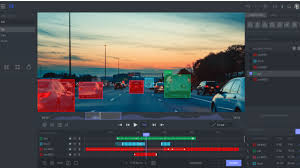

150+
250+
Annotators Onboarded
Happy clients
Bounding Box Annotation
What it is: We draw boxes around moving objects in every frame — from cars to people to animals.
Why it’s useful: It helps AI identify, locate, and track objects over time.
Use cases: Self-driving cars, traffic analysis, retail footfall monitoring, crowd safety.
Polygon & Polyline Annotation
What it is: We trace the outline of irregular shapes (polygon) or draw lines to mark lanes, wires, and edges (polyline).
Why it’s useful: Helps AI detect irregularly shaped objects and road/path boundaries with high accuracy.
Use cases: Road detection, farming equipment automation, electric power line inspections.
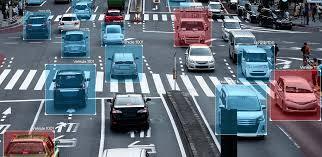

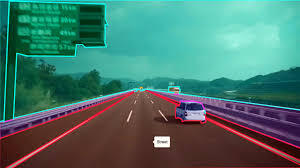

Object Tracking
What it is: We label and follow the same object across multiple video frames.
Why it’s useful: Enables AI to recognize and remember objects even as they move, change size, or get partially hidden.
Use cases: Surveillance, sports tracking, behavior analytics, drone monitoring.
Keypoint & Skeletal Annotation
What it is: We mark key body parts like eyes, hands, joints, etc., and connect them to map body posture.
Why it’s useful: Helps AI understand human poses, actions, gestures, and motion.
Use cases: Fitness tracking, gaming, animation, gesture control, healthcare diagnostics.
Semantic Segmentation
What it is: We label every pixel in a video frame with a specific class — like road, building, tree, sky, etc.
Why it’s useful: Offers deep context for scene understanding at the most granular level.
Use cases: Smart cities, autonomous navigation, agriculture monitoring, disaster response
3D Cuboid Annotation
What it is: We draw 3D boxes around objects to help AI understand depth and spatial positioning as they move.
Why it’s useful: Trains models to estimate distance, volume, and motion more accurately.
Use cases: Robotics, AR/VR, warehouse automation, automotive safety.
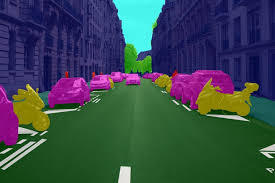

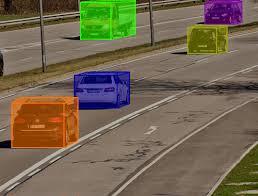

Lane & Road Annotation
What it is: We mark road lanes, shoulders, and curbs to train autonomous systems.
Why it’s useful: Essential for self-driving vehicles and traffic monitoring systems to stay within safe limits.
Use cases: Driver assistance, mapping, transport planning.
Human in Loop + AI Assistence
We combine advanced AI tools with the experience of trained human annotators to deliver accurate, high-speed annotation for any scale of video dataset. Our process ensures consistency, quality, and cost-effectiveness — no matter the complexity.
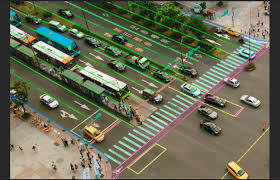

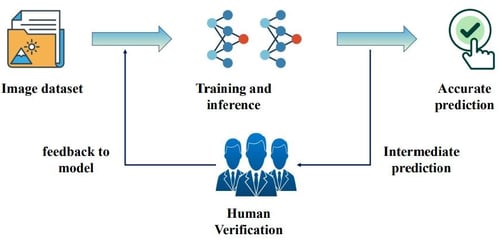

Our 5-Step Process
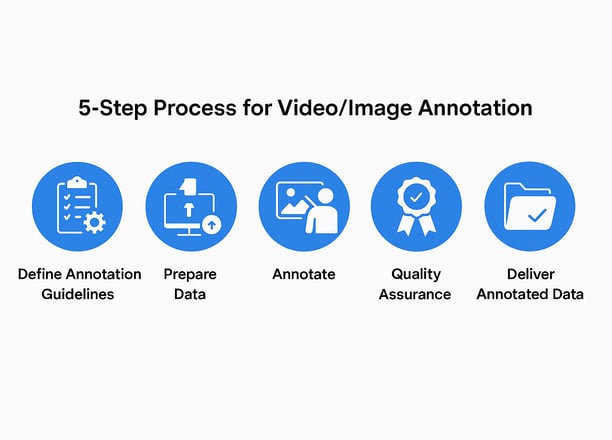

2. Skilled Team Deployment
Pre-trained annotators aligned by domain
3. Tool & Workflow Set-Up
Use of industry tools like CVAT, Label Studio, Roboflow or custom platforms.
1. Consult & Scope
Define goals, label types, and project expectations
Live feedback loops with analytics
Dataset ready for ML training with precision scoring
4. Real Time QA
5. Final Delivery & Review
Industry Use Cases for Video Annotation
1. Autonomous Vehicles & Transportation
Use Case:
Annotating vehicles, pedestrians, road signs, lane markings, and traffic signals across video frames.
Why It Matters:
Video annotation trains self-driving systems to understand surroundings, predict movement, and make safe, real-time decisions.
Applications:
Object tracking for collision avoidance
Lane departure alerts
Traffic light detection
Pedestrian movement prediction
2. Retail & In-Store Analytics
Use Case:
Tracking customer movement, dwell time, product interactions, and queue lengths inside physical stores using CCTV footage.
Why It Matters:
Helps retailers improve layout, optimize product placements, and enhance customer experience using real-time foot traffic insights.
Applications:
Heatmaps for store layout optimization
Checkout queue monitoring
Theft and suspicious behavior detection
3. Healthcare & Medical Research
Use Case:
Annotating surgical procedures, diagnostic imaging videos, and patient movements in rehabilitation.
Why It Matters:
Assists in building medical AI systems for diagnostics, monitoring motor functions, and detecting irregular behavior or postures.
Applications:
AI-assisted surgery tools
Patient posture and fall detection
Video-based remote physical therapy
4. Gaming & Sports Analytics
Use Case:
Tracking players, ball movement, body poses, and game events across match or gameplay footage.
Why It Matters:
Used to enhance player performance analysis, automate highlight reels, or even train sports-focused AI coaches.
Applications:
Motion capture & pose estimation
Automated video highlights
Player fatigue and injury prediction
5. Robotics & Industrial Automation
Use Case:
Training robots to recognize objects, actions, or assembly processes from annotated factory footage.
Why It Matters:
Improves automation, safety, and efficiency in smart manufacturing environments.
Applications:
Robotic arm training
Object handling and sorting
Safety compliance monitoring
6. Drones & Aerial Surveillance
Use Case:
Labeling structures, terrain, or activities in drone footage captured over cities, farmland, or construction sites.
Why It Matters:
Supports AI in mapping, inspection, disaster response, and agriculture monitoring.
Applications:
Crop health detection
Infrastructure inspection (bridges, rooftops)
Crowd analysis and event security
7. Education & EdTech
Use Case:
Annotating gestures, expressions, and engagement levels in classroom or remote learning videos.
Why It Matters:
Helps create AI-driven tools for learning analytics and interactive educational content.
Applications:
Student attentiveness tracking
Gesture-based learning support
Instructor feedback analytics
Frequently asked questions
Why is annotation important for computer vision?
Annotation provides the ground truth needed for training computer vision models. High-quality, accurately labeled images or videos help AI understand and interpret visual content like a human would.
How does video annotation differ from image annotation?
Image annotation deals with static frames, while video annotation involves continuous sequences, often requiring object tracking across multiple frames and time-based labeling for activities or changes.
How do you ensure the quality of annotations?
We use a Human-in-the-Loop (HITL) workflow with multiple quality control layers, expert annotators, review loops, and automation tools to ensure precision and consistency.
Can you handle large volumes of video/image data?
Yes, we are equipped to annotate millions of images or thousands of hours of video content, using scalable annotation pipelines, skilled workforce, and AI-assisted tools.
Is my data secure with your team?
Absolutely. We follow strict data security protocols including NDAs, access controls, encrypted storage, and GDPR-compliant practices to protect your data.
How do I get started?
Answer:
Just send us your project requirements and sample data. We’ll evaluate it, run a test cycle, and provide a proposal tailored to your timeline, budget, and goals.
LabelCo AI
Expert data annotation for AI and machine learning.
Contact
HELLO@labelco.ai
+91-9711151086
Get a custom quote for your annotation project
© 2025. All rights reserved.
